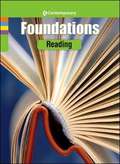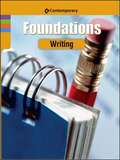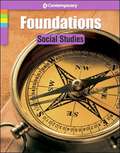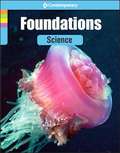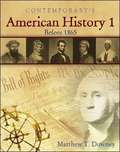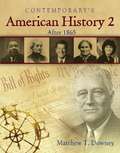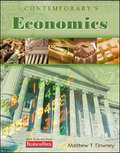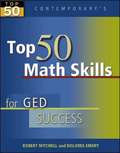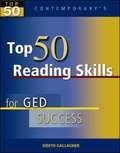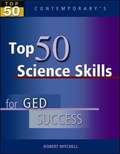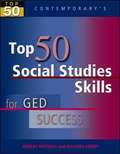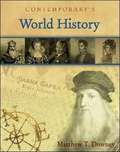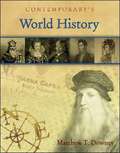- Table View
- List View
More NIMAC books are available at www.nimac.us. If you find your title in the NIMAC and not in Bookshare then please contact us to request it.
Contemporary Foundations: Reading
by McGraw-HillContemporary's Foundations series helps students improve their basic skills. Each book provides skill instruction, offers interesting passages to study, and furnishes opportunities for practice. Foundations provides meaningful contexts for learning, using language which is easy to understand. About Foundations: Reading, Revised Edition: Foundations: Reading will help students improve their reading ability, as well as their writing and thinking skills. Foundations: Reading is divided into four units: Practical Reading: ''survival'' reading that you do everyday. Practical reading includes instructions, advertisements, and explanations. Reading Nonfiction: writing based on facts. Nonfiction includes newspaper and magazine articles, books about real people and real events, and encyclopedia articles. Reading Poetry: verse that captures a person's feelings. Learning to recognize form, rhythm, rhyme, and images will help you read and appreciate poetry. Reading Short Fiction: stories created from an author's imagination. Characters, setting, plot, and theme are important elements in every story. These special features in Foundations: Reading will help students practice language skills: Writing Workshops: detailed instructions that will guide the student through the four-step writing process: prewriting, drafting, revising, and editing Language Tips: explanations, pronunciations, study hints, and background information that will help the student understand what he or she is reading Test Skills: a reminder that this skill is often tested on standardized tests Posttest: a test, evaluation chart, and answer key, to gauge the mastery of each skill. Revised Edition Features: New language tips, Updated content, including revised passages, updated graphs and images, More exercises. About the Series: In Foundations: Reading, students will read practical information, nonfiction, poetry, and short stories. They will learn to find the main point and the details; identify fact, opinion, and bias; make inferences; read photographs and cartoons; and understand rhythm, rhyme, plot, and theme. Writing Workshops, Language Tips, and prereading questions are designed to improve reading, writing, and thinking skills. In Foundations: Writing, students will practice the four steps to writing an essay: prewriting, drafting, revising, and editing. They will read and write five kinds of essays: descriptive essays, personal narratives, how-to essays, essays of example, and comparison-and-contrast essays. A language-skills workbook provides grammar, punctuation, and sentence structure practice. In Your Journal, With a Partner, and Language Tips will help students become better writers, and better readers and thinkers as well. In Foundations: Science, students will learn about the human body, plant biology, physics, chemistry, and Earth science. They will practice putting events in order; reading diagrams, charts, and graphs; using the scientific method; and making comparisons and contrasts. Try It yourself! activities will guide students through simple experiments so they will have a better understanding of what they have been reading about. Writing Workshops and Language Tips will help students use their reading and writing skills to think about science topics. In Foundations: Social Studies, students will learn about world history, U.S. history, civics and government, geography, and economics. They will summarize, make predictions, infer the main idea of cartoons, find information on maps, and read various kinds of graphs. Background Information, Language Tips, and Writing Workshops will let students use what they already know as they read and write about social studies topics. The revised edition includes a new World History chapter. In Foundations: Math, students will practice using whole numbers, money, decimals, fractions, ratios, and percents. Exercises will help students review the addition, subtraction, multiplication, and division facts; round numbers; estimate answers; and solve word problems. Math Notes, On their Calculator, and Language ...
Contemporary Foundations: Writing
by McGraw Hill Wright GroupContemporary'sFoundationsseries helps students improve their basic skills. Each book provides skill instruction, offers interesting passages to study, and furnishes opportunities for practice.Foundationsprovides meaningful contexts for learning, using language which is easy to understand. Foundations: Writingwill help students improve their writing skills, as well as their reading and thinking skills. Part I: Writing helps students practice the four stages of the writing process: Prewriting: planning and organizing Drafting: writing by following a plan Revising: evaluating and rewriting Editing: correcting grammar, mechanics, and usage Students will learn about five types of essays and practice writing each type: Descriptive Essay Personal Narrative How-To Essay Essay of Example Comparison-and-Contrast Essay Part II: Grammar focuses on language skills that writers need to understand. Grammar: nouns, pronouns, verbs, adjectives, and adverbs Punctuation: periods, question marks, exclamation marks, commas, and semicolons Sentence Structure: incomplete sentences, run-on sentences, and comma splices The following special features will help students practice their writing skills. In Your Journal: ideas to think about and write about on your own Language Tip: explanations, pronunciations, study hints, and background information that will help students understand what they read Test Skills: a reminder that this skill is often tested on standardized tests With a Partner: reading, writing, and thinking activities to do with a classmate, family member, or friend Posttest: a test, evaluation chart, and answer key to guage skill mastery Revised Edition Features: New language tips Updated content, including revised passages, updated graphs and images More exercises About the Series: In Foundations: Reading, students will read practical information, nonfiction, poetry, and short stories. They will learn to find the main point and the details; identify fact, opinion, and bias; make inferences; read photographs and cartoons; and understand rhythm, rhyme, plot, and theme. Writing Workshops, Language Tips, and prereading questions are designed to improve reading, writing, and thinking skills. In Foundations: Writing, students will practice the four steps to writing an essay: prewriting, drafting, revising, and editing. They will read and write five kinds of essays: descriptive essays, personal narratives, how-to essays, essays of example, and comparison-and-contrast essays. A language-skills workbook provides grammar, punctuation, and sentence structure practice. In Your Journal, With a Partner, and Language Tipswill help students become better writers, and better readers and thinkers as well. In Foundations: Science, students will learn about the human body, plant biology, physics, chemistry, and Earth science. They will practice putting events in order; reading diagrams, charts, and graphs; using the scientific method; and making comparisons and contrasts. Try It yourself!activities will guide students through simple experiments so they will have a better understanding of what they have been reading about. Writing Workshops and Language Tips will help students use their reading and writing skills to think about science topics. In Foundations: Social Studies, students will learn about world history, U.S. history, civics and government, geography, and economics. They will summarize, make predictions, infer the main idea of cartoons, find information on maps, and read various kinds of graphs. Background Information, Language Tips, and Writing Workshops will let students use what they already know as they read and write about social studies topics. The revised edition includes a new World History chapter. In Foundations: Math, students will practice using whole numbers, money, decimals, fractions, ratios, and percents. Exercises will help students review the addition, subtraction, multiplication, and division facts; round numbers; estimate answers; and solve word problems. Math Notes, On their Calculator, and Language Ti...
Contemporary Foundations: Social Studies
by Wright Group/McGraw-HillContemporary'sFoundationsseries helps students improve their basic skills. Each book provides skill instruction, offers interesting passages to study, and furnishes opportunities for practice.Foundationsprovides meaningful contexts for learning, using language which is easy to understand. AboutFoundations: Social Studies, Revised Edition : In Foundations: Social Studies, students will learn about world history, U.S. history, civics and government, geography, and economics. They will summarize, make predictions, infer the main idea of cartoons, find information on maps, and read various kinds of graphs. Background Information,Language Tips, andWriting Workshops will let students use what they already know as they read and write about social studies topics. The revised edition includes a new World History chapter. About the Series: In Foundations: Reading, students will read practical information, nonfiction, poetry, and short stories. They will learn to find the main point and the details; identify fact, opinion, and bias; make inferences; read photographs and cartoons; and understand rhythm, rhyme, plot, and theme. Writing Workshops, Language Tips, and prereading questions are designed to improve reading, writing, and thinking skills. In Foundations: Writing, students will practice the four steps to writing an essay: prewriting, drafting, revising, and editing. They will read and write five kinds of essays: descriptive essays, personal narratives, how-to essays, essays of example, and comparison-and-contrast essays. A language-skills workbook provides grammar, punctuation, and sentence structure practice. In Your Journal, With a Partner, and Language Tipswill help students become better writers, and better readers and thinkers as well. In Foundations: Science, students will learn about the human body, plant biology, physics, chemistry, and Earth science. They will practice putting events in order; reading diagrams, charts, and graphs; using the scientific method; and making comparisons and contrasts. Try It yourself!activities will guide students through simple experiments so they will have a better understanding of what they have been reading about. Writing Workshops and Language Tips will help students use their reading and writing skills to think about science topics. In Foundations: Social Studies, students will learn about world history, U.S. history, civics and government, geography, and economics. They will summarize, make predictions, infer the main idea of cartoons, find information on maps, and read various kinds of graphs. Background Information, Language Tips, and Writing Workshops will let students use what they already know as they read and write about social studies topics. The revised edition includes a new World History chapter. In Foundations: Math, students will practice using whole numbers, money, decimals, fractions, ratios, and percents. Exercises will help students review the addition, subtraction, multiplication, and division facts; round numbers; estimate answers; and solve word problems. Math Notes, On their Calculator, and Language Tips will help students improve math skills. The revised edition of Math is a major revision. The language has been updated to make the material even easier to follow than before. Foundations series at a glance
Contemporary Foundations: Science
by Wright Group/McGraw-HillContemporary's Foundations series helps students improve their basic skills. Each book provides skill instruction, offers interesting passages to study, and furnishes opportunities for practice.Foundations provides meaningful contexts for learning, using language which is easy to understand. About Foundations: Science, Revised Edition : In Foundations: Science, students will learn about the human body, plant biology, physics, chemistry, and Earth science. They will practice putting events in order; reading diagrams, charts, and graphs; using the scientific method; and making comparisons and contrasts. Try It yourself! activities will guide students through simple experiments so they will have a better understanding of what they have been reading about.Writing Workshops and Language Tips will help students use their reading and writing skills to think about science topics. About the Series: In Foundations: Reading, students will read practical information, nonfiction, poetry, and short stories. They will learn to find the main point and the details; identify fact, opinion, and bias; make inferences; read photographs and cartoons; and understand rhythm, rhyme, plot, and theme. Writing Workshops, Language Tips, and prereading questions are designed to improve reading, writing, and thinking skills. In Foundations: Writing, students will practice the four steps to writing an essay: prewriting, drafting, revising, and editing. They will read and write five kinds of essays: descriptive essays, personal narratives, how-to essays, essays of example, and comparison-and-contrast essays. A language-skills workbook provides grammar, punctuation, and sentence structure practice. In Your Journal, With a Partner, and Language Tips will help students become better writers, and better readers and thinkers as well. In Foundations: Science, students will learn about the human body, plant biology, physics, chemistry, and Earth science. They will practice putting events in order; reading diagrams, charts, and graphs; using the scientific method; and making comparisons and contrasts. Try It yourself! activities will guide students through simple experiments so they will have a better understanding of what they have been reading about. Writing Workshops and Language Tips will help students use their reading and writing skills to think about science topics. In Foundations: Social Studies, students will learn about world history, U.S. history, civics and government, geography, and economics. They will summarize, make predictions, infer the main idea of cartoons, find information on maps, and read various kinds of graphs. Background Information, Language Tips, and Writing Workshops will let students use what they already know as they read and write about social studies topics. The revised edition includes a new World History chapter. In Foundations: Math, students will practice using whole numbers, money, decimals, fractions, ratios, and percents. Exercises will help students review the addition, subtraction, multiplication, and division facts; round numbers; estimate answers; and solve word problems. Math Notes, On their Calculator, and Language Tips will help students improve math skills. The revised edition of Math is a major revision. The language has been updated to make the material even easier to follow than before.
Contemporary's American History 1: Before 1865 [Grade 6-12]
by Matthew T. DowneyAmerican History 1: before 1865covers America's story from its beginning through the end of the Civil War. 20 chapters in provide information about American history from economic, geographic, political, religious, technological, social, and cultural perspectives. Student Edition: Engaging four-color design Unit openers with timelines and discussion questions Pre-reading strategies and introduction activities Reading and vocabulary support Small-group activities Writing activities Primary source documents Chapter summaries with review questions End of chapter skill builder
Contemporary's American History 1: Before 1865 [Grade 6-12]
by Matthew T. DowneyAmerican History 1: before 1865covers America's story from its beginning through the end of the Civil War. 20 chapters in provide information about American history from economic, geographic, political, religious, technological, social, and cultural perspectives. Student Edition: Engaging four-color design Unit openers with timelines and discussion questions Pre-reading strategies and introduction activities Reading and vocabulary support Small-group activities Writing activities Primary source documents Chapter summaries with review questions End of chapter skill builder
Contemporary’s American History 2: After 1865 [Grade 6-12]
by Matthew T. DowneyAmerican History 1covers America's story from its beginning through the end of the Civil War. American History 2begins with Reconstruction and the assassination of President Lincoln, and continues through the modern era. The 20 chapters in each book provide information about American history from economic, geographic, political, religious, technological, social, and cultural perspectives. Highlights: Incorporates the NCSS high school thematic strands Audio and Interactive activities – On the student CD, full audio and interactive activities help the student better comprehend the material, improving their ability to read in the content areas. Reading support – There is extensive attention paid to helping students improve their reading ability. The readability is controlled throughout the program. ELL support – Specific activities target the needs of the second language student Usability – The program is designed to be simple for teachers and students to use. The PDF form of all Teacher CD content makes it easy to print materials as needed. Engaging content - Our series is replete with illustrations, maps, photos and timelines. Value – The program offers a complete, four color social studies curriculum at a very competitive price. Flexibility – the program can be used by a variety of student types, including Adult Ed students.
Contemporary's Economics [Grade 6-12]
by Matthew T. DowneyEconomicscovers basic economic theory and practice and is aligned to the National Council on Economic Education voluntary national standards. Topics include scarcity and choice, the elements of a market economy, market institutions, the national economy, and the global economy. Tangible examples and clear and concise graphics introduce students to the basic principles of economics. Case studies provide teachers with the materials needed to explore current economic issues and create a learning environment that is both enriching and learner centered. Key Features: Business Weekarticles Pre-Reading, During-Reading, and Post-Reading activities Correlates to NCEE lesson plansStudent Text Engaging four-color design Unit openers with timelines and discussion questions Pre-reading strategies and introduction activities Reading and vocabulary support Small-group activities Writing activities Primary source documents Chapter summaries with review questions End of chapter skill builderStudent CD-ROM PDF of entire student book Audio narration of student text Spanish narration of key chapter and lesson concepts Spanish audio activity for each chapter Four interactive games per chapter Student presentation builder
Contemporary’s, Top 50 Math Skills for GED Success [Grade 9-12]
by Robert Mitchell Dolores EmeryTop 50 Math Skills for GED Successis a fast course for the GED Mathematics Test!The text is designed to present the top 50 math skills as a review and practice for students. Each skill is targeted in a single lesson and contains instruction and practice. The text contains a pre-test and a post-test to assess student's skills deficiencies and areas of strength. Pretest The 50-question pretest contains a question for each of the 50 skills most likely to be seen on the GED Mathematics Test. Each question has been organized around the four major content areas of the GED Test. This test is designed to accurately assess which skills require additional study. Each question number is directly correlated to the lesson skill number in the text. Lesson Structure Each lesson is presented in a two-page format. The top of the two-page spread contains the title of the skill. The left page contains instruction and any information relevant to successfully understand the skill. That skill is then applied to an example problem illustrating a step-by-step solution. The right page of the lesson is the GED Readiness page. That page of the lesson is divided into three practice question types: Concept, Procedure, and Application. The bottom of the page references related skills throughout the text. Posttest The posttest inTop 50 Math Skills for GED Successis formatted just like the GED Test, and is designed to assess student's readiness for the GED. An evaluation chart correlates each question to a specific skill as well as to specific review pages within the text. This chart also correlates to the GED Math Satellite book (0-8092-2232-9) for further instruction and practice. Computation Review Section Students can use the Computation Review section for a quick review of the basic math skills important for GED success. Each math skill is presented with an explanation, examples, and brief practice problems. Other Features Top 50 Math Skills for GED Successcontains a detailed Annotated Answer Key, which not only shows the correct answer for each problem in the text but a step-by-step illustration of how the answer was derived. Casio fx-260 instructions are included with an illustration of the calculator face that shows which functions are used on the GED Test. Instructions on using the basic functions and step-by-step examples using the calculator for certain functions are included. An Estimation section illustrates guidelines for estimation using whole numbers, mixed numbers, decimals, and formulas involving Pi. A detailed explanation when to use and when not to use estimation during the GED Test is included along with example problems that illustrate each estimation guideline. Top 50 Math Skills for GED Successcontains a special instructional section on the use of Alternative Answer Formats. Illustrations and instructions on using the grids with whole numbers, decimals, and fractions are included as well as right, left, or center justification explanations. An instruction on using the coordinate plane grid is also included.
Contemporary's, Top 50 Reading Skills for GED Success [Grade 9-12]
by Judith GallagherContemporary'sTop 50 . . . Skills for GED Successis a program designed toquicklyprepare students for the GED Tests. These Textbooks can be used in a variety of ways: Student-directed self-study One-on-one instruction Group instruction Top 50 . . . Skills for GED Successorganizes each GED Test subject into 50 manageable skills, identified by the GED Testing Service. The format of each text is very easy to follow and is organized into instruction and practice sections. Pretest and Posttest The pretest contains a question for each of the skills most likely to be seen on the actual GED Test. The posttest is formatted just like the GED Test! Students can use the posttest to practice taking the GED test under real test-taking conditions, as well as an evaluation tool to determine readiness for the real GED Test. Lesson Format Each lesson in the text is introduced in a two-page format. The left page is the Skill Instruction page and the right page is the GED Readiness page. The GED Readiness page provides practice questions in the same format as the actual GED Test.
Contemporary's, Top 50 Science Skills for Ged Success [Grade 9-12]
by Robert MitchellContemporary'sTop 50 . . . Skills for GED Successis a program designed toquicklyprepare students for the GED Tests. This Textbook can be used in a variety of ways: Student-directed self-study One-on-one instruction Group instruction Top 50 . . . Skills for GED Successorganizes each GED Test subject into 50 manageable skills, identified by the GED Testing Service. The format of each text is very easy to follow and is organized into instruction and practice sections. Pretest and Posttest The pretest contains a question for each of the skills most likely to be seen on the actual GED Test. The posttest is formatted just like the GED Test! Students can use the posttest to practice taking the GED test under real test-taking conditions, as well as an evaluation tool to determine readiness for the real GED Test. Lesson Format Each lesson in the text is introduced in a two-page format. The left page is the Skill Instruction page and the right page is the GED Readiness page. The GED Readiness page provides practice questions in the same format as the actual GED Test.
Contemporary's, Top 50 Social Studies Skills for Ged Success [Grade 9-12]
by Kenny TamarkinContemporary'sTop 50 Social Studies Skills for GED Successis a program designed toquicklyprepare students for the GED Tests. The Textbook can be used in a variety of ways: Student-directed self-study One-on-one instruction Group instruction Top 50 Social Studies Skills for GED Successorganizes the GED Test subject into 50 manageable skills, identified by the GED Testing Service. The format of each text is very easy to follow and is organized into instruction and practice sections. Pretest and Posttest The pretest contains a question for each of the skills most likely to be seen on the actual GED Test. The posttest is formatted just like the GED Test! Students can use the posttest to practice taking the GED test under real test-taking conditions, as well as an evaluation tool to determine readiness for the real GED Test. Lesson Format Each lesson in the text is introduced in a two-page format. The left page is the Skill Instruction page and the right page is the GED Readiness page. The GED Readiness page provides practice questions in the same format as the actual GED Test.
Contemporary's World History: Blackline Masters [Grade 6-12]
by McGraw-HillWorld History, written at the 5 to 8 reading level, is an integrated series of print and electronic resources designed to provide a complete classroom solution for students who need extra support. Every chapter and lesson in the student book contains features and activities to keep students engaged in the learning process. The student CD-ROM, the Annotated Teacher's Edition, and the Teacher's Resource Binder all provide additional materials for English Language Learners. World Historyincorporates the National Council for the Social Studies (NCSS) high school thematic strands. The book covers events beginning with pre-history and continues through the modern era. ANCILLARY MATERIALS Student Edition CD-ROM PDFs of all student book pages Audio narration of each page in the student book Spanish audio introduction of each key chapter concept Spanish audio ELL activity for each chapter Four instructional, activities per chapter Student Presentation Builder Interactive historical timeline Interactive Glossary Annotated Teacher's Edition Reduced student pages with wrap-around teacher notes Teaching objectives for each lesson Lists of classroom materials Extension activities Vocabulary lessons Literary connections Classroom discussions Teacher's Resource Binder Includes Annotated Teacher's Edition 160 blackline masters, eight per chapter, consisting of a reading comprehension activity a vocabulary reinforcement activity an additional biography an additional primary source document a map activity a chapter activity a chapter review a chapter quiz 20 full-color overhead transparencies CD-ROM consisting of the following PDFs entire Annotated Teacher's Edition one test per unit one full book assessment one ELL reading activity per chapter one ELL vocabulary activity per chapter one puzzle per chapter
Contemporary's World History [Grade 6-12]
by Matthew T. DowneyWorld Historybegins with prehistory and continues into the 21st century. Incorporating both early world history and modern world history, this text offers a broad-reaching examination of the events that led to the world of today. Case studies provide teachers an opportunity to expand chapter topics and incorporate issues that face citizens around the world. Highlights: Incorporates the NCSS high school thematic strands Audio and Interactive activities - On the student CD, full audio and interactive activities help the student better comprehend the material, improving their ability to read in the content areas. Reading support - There is extensive attention paid to helping students improve their reading ability. The readability is controlled throughout the program. ELL support - Specific activities target the needs of the second language student Usability - The program is designed to be simple for teachers and students to use. The PDF form of all Teacher CD content makes it easy to print materials as needed. Engaging content - Our series is replete with illustrations, maps, photos and timelines. Value - The program offers a complete, four color social studies curriculum at a very competitive price. Flexibility - the program can be used by a variety of student types, including Adult Ed students. Format Descriptions: Teacher's Resource Binder Includes annotated teacher's edition Blackline masters with answer key Reading comprehension activities Vocabulary reinforcement activities Additional biographies Additional primary source documents Chapter activities, reviews, quizzes Full-color overhead transparencies Teacher CD-ROM Additional blackline masters Full book assessment Unit tests and chapter quizzes ELL reading comprehension activities ELL vocabulary reinforcement activities Chapter puzzles Complete annotated teacher's edition in PDF format Student Text Engaging four-color design Unit openers with timelines and discussion questions Pre-reading strategies and introduction activities Reading and vocabulary support Small-group activities Writing activities Primary source documents Chapter summaries with review questions End of chapter skill builder Annotated Teacher's Edition Reduced student pages with detailed classroom and teacher support Lesson objectives Key materials identified Extension activities Vocabulary lessons Literary connections Classroom discussions Answers to student questions Student CD-ROM PDF of entire student book Audio narration of student text Spanish narration of key chapter and lesson concepts Spanish audio activity for each chapter Four interactive games per chapter Student presentation builder

